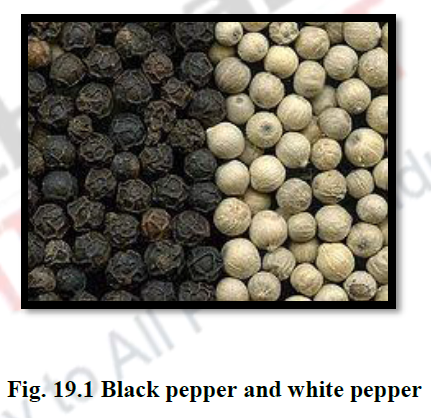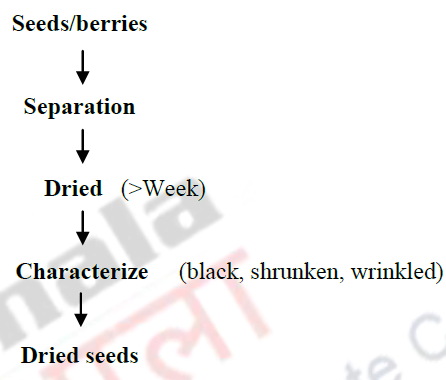9 Pepper: Refining
9. Introduction: Pepper refining
Pepper is cultivated since millennia. Pungent and aromatic, it is grown in southern India. Black pepper is a flowering vine cultivated for its fruit, which is refined and used as a spice and seasoning. The fruit, known as peppercorn when dried, become dark red and black when fully matured. Depending upon the harvest time and processing, peppercorn can be black, white, green and red. So the same fruit can be utilized to produce white pepper, red pepper and green pepper.
The black and white pepper is already known and green pepper is a recent innovation. Black Pepper Seeds have hot pungent taste and add mesmerizing aroma to a dish. Along with this, Black Pepper Seeds are enriched with medicinal content. Pepper loses flavour and aroma through evaporation, so airtight storage helps preserve its spiciness longer. Pepper can also lose flavour when exposed to light, which can transform piperine into nearly tasteless isochavicine.
Pepper gets its spicy heat mostly from the piperine compound, which is found both in the outer fruit and in the seed. Black pepper contains between 4.6% and 9.7% piperine by mass, and white pepper slightly more than that. Refined piperine, by weight, is about one percent as hot as the capsaicinin chili peppers. The outer fruit layer, left on black pepper, also contains important odour-contributing terpenes including pinene, sabinene, limonene, caryophyllene, and linalool, which give citrusy, woody, and floral notes.
9.2 Harvesting
Pepper vine fruit comes after one year of planting and transform from flower to a fruit within 6-9 months. First harvest is taken in 3rd year of planting. The pepper fruit are harvested during fully mature stage before full ripening. Spikes are rubbed / scrubbed/ trampled to detach fruits. Average yield of dry pepper is 18-20 g/ha.
9.3 Processing:
Berries are separated from spikes & dried in shade for 7-10 days on under sun till it becomes crisp, black, shrunken & consume characteristic and have wrinkled appearance of spice of commence. The drupes are cooked briefly in hot water, and are prepared for drying. Berries are turned over periodically for better exposure to heat, to improve color and appearance. Green pepper is soaked in hot water for a min before drying to prevent Microbial and enzymatic activation or contamination.
9.4 Types of refining processes are:
9.4.1 Steam boiling
Ripened bevies are boiled for about 15 min. and de-pulping was done. The peppers are subsequently washed, bleached, drained in & dried. White pepper is white inner corn obtained by removing outer skin (pericarp) of fully and berries wither before (or) after drying.
9.4.2 Retting Process
The most widely practiced method of production is retting, a crude process that begets only inferior quality white pepper. A limited quantity of white pepper is also being managed through selective decortications of ripened fresh pepper berries. Decorticated black pepper is a form of white pepper produced by decortications (dismantling) of the outer skin of black pepper. This is generally done when white pepper is in short supply. The dismantling process is achieved through careful mechanical stripping (rarely done), chemical treatment (poor acceptance) or biological methods. Though fetching comparatively better quality white pepper, the cumbersome methodology has acted as a dampener. Also, the process can be employed during selected periods only.
9.4.3 Biological Process
The biological process is preferred to others since it enables preparation of skin-free pepper, without foreign substance getting added or valuable ingredients being flushed out of the kernel. This technology has been patented: a fast, simple and pollution-free microbial technology that ensures production of better quality white pepper. It also yields methane energy as a by-product. The new technology is now under commercial implementation at the Wayanad Social Service Society (WSSS),
Mananthavady, in north Kerala. WSSS has plans to set up a bigger plant to meet its export demand. The biogas being produced would be trapped for energy applications. Ancient method was to burry the pepper inside the soil in underground pits.
| you can view video on Pepper: Refining |


